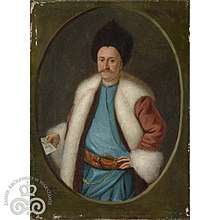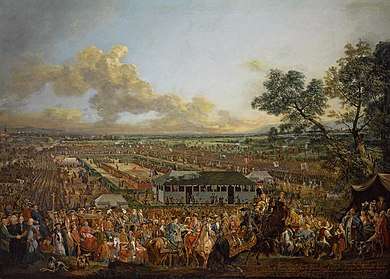Antonio Crutta
Antonio Crutta (Polish: Crutta Łukasz Antoni, Albanian: Antonio Kruta, 1727 – June 11, 1812) was a diplomat and politician in the Polish court for around 30 years in the reign of Stanisław August Poniatowski. For his services, to the Polish state he was ennobled in 1792.
Crutta Łukasz Antoni Antonio Crutta | |
|---|---|
 Crutta Łukasz Antoni or Antonio Crutta | |
| Born | 1727 Cyprus |
| Died | June 11, 1812 |
| Occupation | diplomat, interpreter |
| Years active | ca. 1747-1799 |
Life and family
His father was Albanian and descended from the Albanian Kruta (Kryethi) tribe.[1][2] His mother was Italian.[3] The family has established themselves in Pera since 1693. They were known to serve Russian, French, English, Polish and Venetian embassies as interpreters.[4] Another member of the family titled "Doctor Crutta" or "Signor Crutta" is mentioned as a dragoman and chancellor in service of the British embassy between 1745 and 1764 in the European colony of Larnaca.[5][6]
Crutta entered early in the service of Poland on January 1, 1748, as the chancellor of the Republic of Venice in Larnaca in Cyprus. He worked in Cyprus until 1765 when he arrived through the British ambassador to Constantinople to transmit his offers to the King of Poland. Descorches and Crutta worked to withdraw the Ottoman Empire from war in order to maintain the peace with Poland, but due to the insurrection, their work was useless. He asked the Royalty to pay off his old debts which he had acquired in Cyprus and Istanbul and the Polish king paid 23 ducats a month, which Crutta deemed insufficient for his services and complained.[7] He spoke 9 languages. His personal name in archival documents has been spelled as Antonio, Antoine and Antoni. His brother Pierre, and his son Jean, followed in the same tracks, and worked in Istanbul, trying to persuade the French to help the Poles form an alliance. He received an English passport by the English ambassador in Warsaw and travelled to Constantinople where he met French diplomat Marie Louis Descorches. However Tadeusz Kościuszko, who had sent Pierre on the mission, was overthrown and Pierre remained in Istanbul until he died in 1797. Crutta had also served in the British embassy under John Murray, as one of its many "Levantine" (Catholic and Italian-speaking) translators.[8]
His brother, Joseph Crutta, was also a dragoman for the Russian embassy in Istanbul. He spent several years in prison in the Château des Sept Tours together with Russian ambassador Vasily Repnin.[9][10] There exists a well-known portrait of Antoine Crutta, painted by Canaletto, representing the election of King Stanisław August Poniatowski in 1764. Joseph Crutta wanted to stay in Istanbul and work as the Russian consul as the Russian climate could prove fatal.[11] Joseph Crutta apparently died in 1780 from drug abuse and so did his brother Alexander Crutta.[12] He served as interpreter and translator of King Stanisław August Poniatowski during the Russo-Turkish war of 1787-92 in Poland.[13][14] His role in the negotiations was to "melt the suspicions of the Turks without arousing the suspicions of the Russians".[14]
Antonio Crutta was also a politician and translator of Oriental languages. He lived in Lewiczyn in the Belsk Duży commune. The Poles called him "Albanian Antoni Lukasz Crutta" and he was a cherished dragoman of the Byzantine and Middle East. He was also a guide and intermediary between foriengers and inhabitants of the Orient. Prior to his service to the Polish king, Crutta had served in the Court of Venice in Cyprus. He spoke Latin, Greek, French, English, Italian, Armenian, Turkish, Tatar and Persian.[15] In 1777, he accompanied MP Numanbey, representing the Ottoman Sultan, and translating Treaty Documents. In 1792, for his services in helping maintain the peace between Poland and the Ottomans that he was ennobled by the Rzeczpospolita. He spent the last years of his life in Lewiczyn, in the estates of his son-in-law, Wojciech Piotr Bedliński. He died there on June 11, 1812 and is buried in Lewiczyn, near his daughter Eliza and her husband Wojciech Bedliński.[16] His grandson, Antoni Bedliński built him a monument which depicts Crutta's name and the Wieniawa coat of arms.[16]
Depiction in painting

Antonio is depicted in Bernardo Bellotto's painting "Election of Stanislas Augustus" from 1776 and 1778. Mieczyslaw Wallis describes him as follows:
Standing in front of the tent, a stout grand man, deed in a fur cap and blue coat, in floral zupper and red greyhounds with a dagger stuck behind his belt, looking through the magnifying glass of the election, an expert in Eastern languages and head office of the Crown Chancellery, Antoni Łukasz Crutta (1725-1812), Albanian, or more specifically Italian, Albanian, probably a Venetian citizen who arrived in 1765 Warsaw, in 1775 he obtained an indigenate, and on February 26, 1778 he received the title of consistory officer in foreign countries.[17][18]
References
- Čoralić, Lovorka (2009). "The Albanian Kruta family and some of its eminent individuals – a contribution to the research of communications on the eastern adriatic coastline in the early Modern age". HISTORIJSKI ZBORNIK GOD. LXII. 2: 389. Retrieved April 1, 2020.
- de Groot, Alexander H. (1994). "Dragomans in Istanbul, 1785-1834". In van Gelder, G. J. H.; de Moor, Ed (eds.). Eastward Bound: Dutch Ventures and Adventures in the Middle East. Rodopi. p. 138. ISBN 9051837178. Retrieved April 1, 2020.
- "Collection of Royal Castle in Warsaw - Antoni Łukasz Crutta. ( Antoni Łukasz Crutta Signed and dated bottom left: Duchâteau/ Pinxit/ 1779 (the last digit is barely visible). Jean-François Duchâteau (d. after 1796); French painter active in Istanbul and connected with the diplomatic corps. Antoni Łukasz Crutta (1727–1812), was born in Cyprus. The son of an Albanian father and Italian mother, he was clerk and translator/interpreter to the Venetian consulate in Larnaca. From 1765 he was in the service of Stanisław August as translator of oriental languages; he was made a nobleman in 1775. Pendant to the portrait of his wife (ZKW/722/ab)". kolekcja.zamek-krolewski.pl.
- Gelder, G. J. H. van; Moor, Ed de (1994). Eastward Bound: Dutch Ventures and Adventures in the Middle East. Rodopi. p. 138. ISBN 978-90-5183-717-9.
- Drummond, Alexander (1754). Travels Through Different Cities of Germany, Italy, Greece and Several Parts of Asia, as the Far as the Banks of the Euphrates, in a Series of Letters... by Alexander Drummond,... The autor. p. 280. Retrieved March 31, 2020.
- Kitromilides, Paschalis (2019). Insular Destinies: Perspectives on the history and politics of modern Cyprus. Routledge. ISBN 978-1-351-12780-6. Retrieved March 31, 2020.
- Polish archives of oriental research (in French). Państwowe Wydawn. Naukowe. 1961. pp. 85–88, 93. Retrieved March 31, 2020.
- Michael Tarbot (2017). British-Ottoman Relations, 1661-1807: Commerce and Diplomatic Practice in Eighteenth-century Istanbul. Boydell & Brewer. p. 152.
- Deutsche Akademie der Wissenschaften zu Berlin. Institut für Griechisch-Römische Altertumskunde, Deutsche Akademie der Wissenschaften zu Berlin. Zentralinstitut für Alte Geschichte und Archäologie, Universität Halle-Wittenberg. Sektion Orient- und Altertumswissenschaften. University of Michigan: Akademie-Verlag. 168. p. 308. Retrieved March 31, 2020.
- Ward, Sir Adolphus William (1907). The Cambridge Modern History. CUP Archive. Retrieved March 31, 2020.
- Archives polonaises d'etudes orientales (in French). Towarzystwo. 1961. pp. 96–97.
- Actes. 1959. pp. 609–611. Retrieved March 31, 2020.
- Reychman, Jan; Zajaczkowski, Ananiasz (2014). Handbook of Ottoman-Turkish Diplomatics. Walter de Gruyter GmbH & Co KG. p. 20. ISBN 978-3-11-081269-5. Retrieved March 31, 2020.
- Roland, Ruth A. (1999). Interpreters as Diplomats: A Diplomatic History of the Role of Interpreters in World Politics. University of Ottawa Press. p. 49-50. ISBN 978-0-7766-0501-2. Retrieved March 31, 2020.
- "Crutta Łukasz Antoni - Gmina Belsk Duży". www.belskduzy.pl (Life and death of Crutta Łukasz Antoni). Belskduzy commune. Retrieved April 1, 2020.
- Reychman, Jan (1968). "Une famille albanaise au service de la Pologne au XVIII". Berliner byzantinistische Arbeiten: 307. Retrieved April 27, 2020.
Il mourut le ll juin 1812, juste avant les grands événements qui allaient de nouveau bouleverser la vie de sa seconde patrie. Son petit-fils, Bedliński, y fit construire un beau monument tombal avec ses armes.
- Państwowy Instytut Sztuki [Hrsg.]; Stowarzyszenie Historyków Sztuki [Hrsg.]: Biuletyn Historii Sztuki (16.1954) (in German). Retrieved April 2, 2020.
- RFI partenaire de l’exposition “Bernardo Bellotto. Tableaux du Château Royal de Varsovie” et du cycle “Identités polonaises : patrimoine et création à l’auditorium du Louvre” (PDF) (On the right, at the very edge of the painting, we can see Bellotto in profile, in a tent, seated at a table with his three daughters as well as, standing before them, Antoni Lukasz Crutta, the king's translator for languages oriental. ed.). www.louvre.fr. Retrieved April 2, 2020.